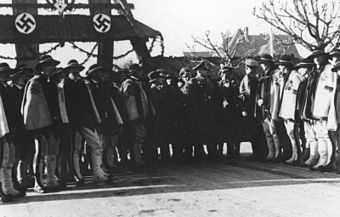Goralenvolk

Goralenvolk was the name given by German Nazis in World War II to the population of Podhale region in the south of Poland near the Slovakian border. In an effort to divide the Polish nation during their occupation of Poland the Germans postulated a different ethnicity for people of that region. The term Goralenvolk was derived from the Polish word Górale (the Highlanders) commonly referring to the people living in the mountains. In order to make Gorals collaborate, the Nazis proclaimed that this group were part of the Greater Germanic Race and worthy of separate treatment from the rest of the Poles.[1][2]
Origin
Nazi ideology claimed that Gorals (Górale) were descended from ethnic Germans who allegedly settled in that region during medieval times in significant numbers. They were considered by the Nazi ideologues to be a part of the "Greater Germanic Race". The concept of the Gorals being from German descent did not originate with the Nazis themselves. For example, the 1885 Meyers Konversationslexikon entry under Goralen stated, that Germans (also) lived in that area in the 11th century but were slavicized.[3]
German occupation
.jpg)
The region inhabited by Górale (pre-war Polish Nowy Targ County in Podhale) was annexed by Germany immediately after the Invasion of Poland in 1939. Later, the German authorities attempted to assimilate the population into the body of Volksdeutsche, and to encourage their collaboration with the occupying forces. Soon, a small group of local collaborators gathered under the leadership of Reichsdeutscher Witalis Wieder, with Wacław Krzeptowski – a self-proclaimed Goralenführer – and his cousins Stefan and Andrzej Krzeptowski, as well as suspected German spy Henryk Szatkowski, and Józef Cukier from Zakopane. During a visit of Nazi Governor-General Hans Frank to Podhale on November 7, 1939 they proposed to establish a separate state for Goralenvolk. Most fled to Germany at the end of the war except for Krzeptowski himself, who decided to hide in the mountains (at na Stołach) in a secluded shack. He was apprehended by the Polish Armia Krajowa unit under Lieutenant Tadeusz Studziński, charged with high treason and hanged on January 20, 1945.[4]
The implementation of the Goralenvolk action aimed at germanization of the Polish highlanders was actively opposed by the underground Tatra Confederation, a Polish resistance organization founded in May 1941 in Nowy Targ (the historical capital of Podhale), by the poet and partisan, Augustyn Suski (nom-de-guerre Stefan Borusa) with Tadeusz Popek (Wacław Tatar) as his deputy and Jadwiga Apostoł (nom-de-guerre Barbara Spytkowska) as their administrative secretary. Suski died at the Auschwitz concentration camp. Popek was tortured and executed in Zakopane.[2][5][6]
A German census conducted in 1940 showed that 72% of the local Goralenvolk population identified themselves as Polish rather than ethnic German. This result was a great disappointment to the collaborators and the occupiers alike. After attempts to revive the idea during the following years proved unsuccessful, the Germans abandoned the project in 1943. With the arrival of the Allied troops towards the end of the war, the short-lived existence of the so-called Goralenvolk initiative became a footnote of history.
See also
Notes and references
- ↑ "Pod Giewontem. Losy mieszkancow Podhala 1939-1956". Podhalański Portal Informacyjny Podhale24.pl. September 12, 2011. Retrieved April 21, 2012.
- ↑ 2.0 2.1 "Historia rodziny Apostołów". Lista świadków historii (in Polish). Stowarzyszenie Auschwitz Memento. Retrieved April 21, 2012.
- ↑ Meyers Konversationslexikon: Band 7, Seite 518: von Göppingen bis Gordianus.
- ↑ "Góralski Legion Waffen SS". Polacy po stronie Niemców. Wiedza i Zycie, Inne Oblicza Histori. No. 07 - 02/2005. Last updated: December 13, 2005. Retrieved May 20, 2012.
Page archived by Wayback Machine
Check date values in:|date=(help) - ↑ "Góralska Dywizja Waffen-SS". Forum Druga Wojna Światowa dws.org.pl. Retrieved April 24, 2012.
- ↑ "Konfederacja Tatrzańska (with biographies and photographs)". Konfederat Tatrzański. Retrieved April 24, 2012.
| Wikimedia Commons has media related to Goralenvolk. |
- 1939 proposal for a Goralenfolk flag (it was never officially accepted)
- "Goralenvolk", National Digital Archive, Poland